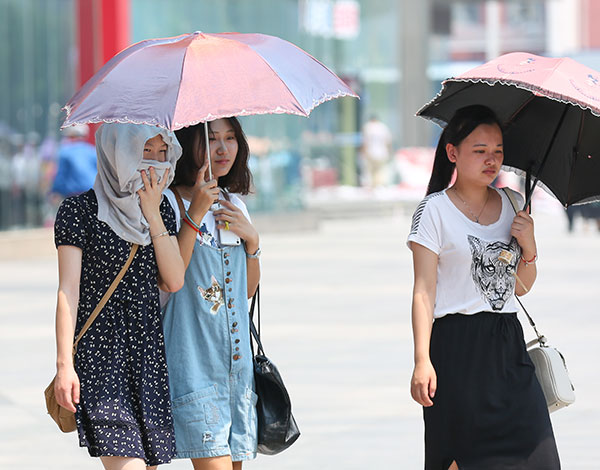
People protect themselves from the sun in Zhengzhou, Henan province, as the temperature in the city hit a high of 38 C on Wednesday. (Photo/China Daily)
"It is vital for people in those areas to keep close tabs on the weather alerts and react in time to the early warnings by authorities," Zhang said.
It is still difficult to forecast whether Yangtze River areas will experience similar flooding to that of 1998, forecaster He said.
"The patterns of El Nino and the subtropical ridge are all similar to that of 1998. But it is still too early to know whether we can expect a similar lingering rainfall," he said.
In 1998, the basin areas of the Yangtze River experienced more than 70 days of torrential rainfall. Those storms eventually triggered a major flood that left at least 1,800 people dead, with more than 100 million people affected.
Floods triggered by heavy rain left 22 people dead and 15 others missing in South China since Saturday, according to the State Flood Control and Drought Relief Headquarters.
Ancient relics saved from damage
Bamboo slips dating back to the Qin Dynasty (221-206 BC) have been preserved unscathed despite a major flood inundating the ancient town of Liye in Longshan county, Hunan province.
"Only the first floor of the Liye Qin Slips Museum has been flooded. But to prevent the flood from damaging the bamboo slips, they have been relocated to the third floor of the museum together with some other cultural relics," said Zhang Jun, a county official.
The flood, which inundated the ancient town, began to recede on Wednesday, reducing the flooded area to 0.75 sq km from 2.1 sq km on Sunday.
Some 3,000 residents were still homeless on Wednesday.
Located at the juncture of Hunan, Hubei and Guizhou provinces and Chongqing municipality, Liye, which means "to explore" in the Tujia language, was inhabited by humans 6,000 years ago.
In 2002, archaeologists unearthed nearly 40,000 pieces of Qin Dynasty bamboo slips there.
The county has excavated the largest number of Qin bamboo strips, on which people wrote before the invention of paper. Only 10,000 Qin slips had been found before this major discovery.


















































